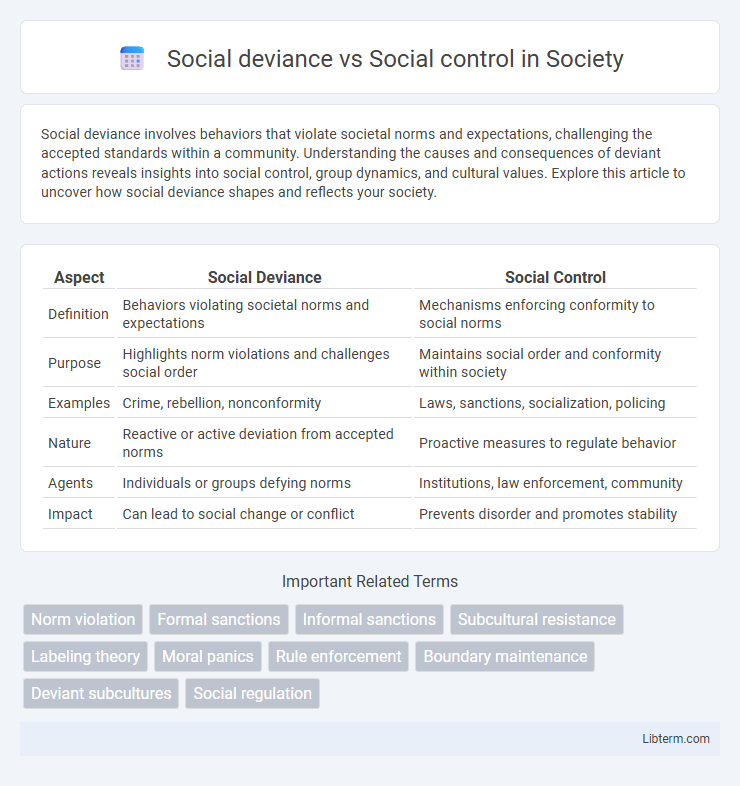Social deviance involves behaviors that violate societal norms and expectations, challenging the accepted standards within a community. Understanding the causes and consequences of deviant actions reveals insights into social control, group dynamics, and cultural values. Explore this article to uncover how social deviance shapes and reflects your society.
Table of Comparison
| Aspect | Social Deviance | Social Control |
|---|---|---|
| Definition | Behaviors violating societal norms and expectations | Mechanisms enforcing conformity to social norms |
| Purpose | Highlights norm violations and challenges social order | Maintains social order and conformity within society |
| Examples | Crime, rebellion, nonconformity | Laws, sanctions, socialization, policing |
| Nature | Reactive or active deviation from accepted norms | Proactive measures to regulate behavior |
| Agents | Individuals or groups defying norms | Institutions, law enforcement, community |
| Impact | Can lead to social change or conflict | Prevents disorder and promotes stability |
Understanding Social Deviance: Definition and Types
Social deviance refers to behaviors or actions that violate cultural norms or societal expectations, encompassing a wide range of activities from minor infractions like dress code violations to serious crimes such as theft or assault. Types of social deviance include formal deviance, which involves criminal behavior punishable by law, and informal deviance, which breaks unwritten social rules but often lacks legal consequences. Social control mechanisms, both formal (laws, policing) and informal (socialization, peer pressure), function to regulate and mitigate deviant behaviors to maintain social order.
The Concept of Social Control: Purpose and Mechanisms
Social control refers to the mechanisms, strategies, and institutions society uses to regulate individual behavior and maintain social order. Its primary purpose is to enforce norms and prevent deviance by promoting conformity through formal sanctions (laws, policing) and informal controls (peer pressure, socialization). These mechanisms include legal regulations, educational systems, family influence, and media, all functioning to uphold societal values and cohesion.
Theoretical Perspectives on Deviance and Control
Theoretical perspectives on social deviance and social control highlight the dynamic relationship between societal norms and behaviors that challenge those norms. Structural functionalism views deviance as a necessary element for social cohesion, emphasizing mechanisms like laws and sanctions that reinforce social order. Conflict theory focuses on power disparities, asserting that definitions of deviance and social control practices primarily protect dominant group interests, while symbolic interactionism examines how deviance is constructed through social interactions and the labeling process.
Formal vs Informal Social Control
Formal social control involves official mechanisms such as laws, police, courts, and prisons designed to enforce societal norms and punish deviance. Informal social control relies on unwritten rules, socialization, peer pressure, and community norms to guide behavior and maintain social order. The interplay between formal institutions and informal social networks shapes responses to social deviance and maintains societal cohesion.
Factors Contributing to Social Deviance
Factors contributing to social deviance include cultural norms, socialization processes, and structural inequalities that create deviant behavior patterns. Social control mechanisms, such as laws, sanctions, and institutional regulations, function to mitigate deviance by reinforcing conformity. The balance between deviance and social control shapes social order and influences individual behavior within a community.
The Role of Law in Controlling Deviance
Law serves as a formal mechanism of social control by defining acceptable behavior and prescribing penalties for deviance, thereby maintaining social order. Through codified statutes and judicial enforcement, law deters deviant actions by establishing clear consequences, reinforcing societal norms. The legal system functions not only to punish but also to rehabilitate offenders, promoting conformity and reducing the prevalence of deviant behavior within communities.
Social Institutions and the Enforcement of Norms
Social institutions such as family, education, religion, and law enforcement play critical roles in the enforcement of social norms to regulate deviant behavior. These institutions establish rules and sanctions that guide individual conduct, ensuring societal stability by promoting conformity and addressing deviance through mechanisms like socialization, legal penalties, and moral guidance. Effective social control relies on institutional authority to maintain order and integrate individuals into accepted cultural standards.
Deviance, Stigma, and Social Labeling
Social deviance refers to behaviors that violate societal norms, often attracting stigma that marks individuals as outsiders or morally inferior. The process of social labeling assigns deviant identities to those who break rules, reinforcing their marginalization and potentially perpetuating further deviance. Stigma associated with deviance affects social interactions and access to opportunities, influencing individual self-identity and societal responses.
Effects of Social Control on Individual Behavior
Social control mechanisms, such as laws, norms, and sanctions, regulate individual behavior by promoting conformity and discouraging deviance through rewards and punishments. Effective social control fosters social order and reduces instances of deviant behavior by reinforcing societal expectations and internalizing norms within individuals. However, excessive or oppressive social control can lead to resistance, stress, or alienation, impacting individual autonomy and mental well-being.
Balancing Social Order: Challenges and Contemporary Issues
Balancing social order requires addressing the tension between social deviance, which challenges norms and prompts change, and social control, which enforces conformity through laws, norms, and sanctions. Contemporary issues include managing diverse cultural expressions and digital behaviors that blur traditional boundaries of deviance and control. Effective social control must adapt to evolving social dynamics while respecting individual freedoms to maintain cohesion and prevent social fragmentation.
Social deviance Infographic

 libterm.com
libterm.com